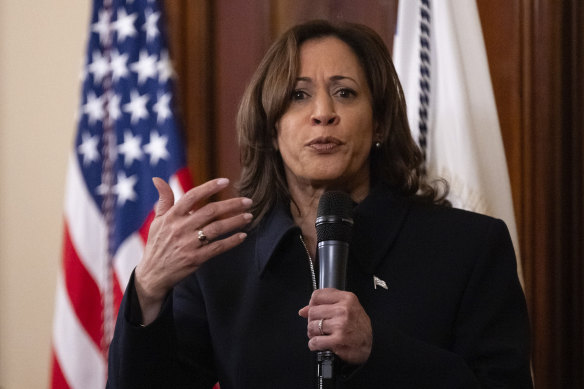
Based on its central estimates, however, Harris’ plan would increase the debt-to-GDP ratio to 133 per cent in the 2035 financial year and Trump’s to 142 per cent of GDP. The record US ratio of 106 per cent was set in 1946, in the immediate aftermath of World War II.
The big ticket items in both candidates’ platforms are their tax plans.

Kamala Harris backs generous tax benefits for working-class Americans and paying for them with bigger tax increases on companies.Credit: AP
Harris, who won’t extend Trump’s 2017 tax cuts for those earning more than $US400,000 a year when they expire next year, also wants to expand child tax credits. Those two proposals alone would cost $US4.4 trillion, according to the CFRB central estimates.
Increased tax revenue from companies and the wealthy, however, would raise about $US4 trillion.
The biggest items in Trump’s platform are the extension of the 2017 tax cuts and a layer of new cuts, the exemption of overtime income from taxes and the abolition of taxes on social security benefits. Combined, they would cost about $US8.65 trillion.
Loading
His controversial plan to detain and deport many millions of immigrants and strengthen border security would cost $US350 billion, with a “high” cost of $US1 trillion.
On the revenue side, the CFRB has estimated he would raise $US2.7 trillion from his universal baseline tariff on imports and 60 per cent tariff on imports from China, and save $US700 billion by unwinding Joe Biden’s climate-related policies.
Tariffs are Trump’s “magic pudding”. He regards them as an endless source of revenue that he believes will be paid by America’s trade partners rather than, as almost everyone else understands, US companies and consumers.
They are, as was demonstrated by the impact of his 2018 tariffs on imports from China, a consumption tax.
The ITEP looked at the overall impact of Trump’s planned new tax and tariff regimes on the various income groups. If the proposed changes were in place in 2026, it said, the richest 1 per cent of Americans would receive an average tax cut of about $US36,300 and the next richest 4 per cent a cut of about $US7,200.
All other income groups would experience tax increases, with the middle 20 per cent paying about $US1500 a year more on average and the lowest-income 20 per cent of Americans about $US800, or nearly 5 per cent of their average incomes.
In other words, Trump’s policies would be regressive, adding to the income and wealth inequality in an economy that already has the greatest wealth inequality of any advanced economy.
Both campaigns, of course, say that their policies wouldn’t add to debt and deficits, with Harris’ saying her new spending would be offset by revenue increases and Trump’s arguing that his 2017 tax cuts generated “robust, non-inflationary growth” that generated more revenue for the government.
The broad overview of Harris’ platform is that it is classically progressive.
Trump made that argument in support of his tax cuts for companies and the wealthy during his last term in office, when he promised the growth they ignited would reduce deficits and debt.
During that term, US government debt increased by almost $US8 trillion, on some counts, the third-largest increase in debt, relative to GDP, in US history.
The broad overview of Harris’ platform is that it is classically progressive, taxing companies and the rich more to benefit the poor and middle class.
Trump, because of the nature of his tax cuts, which favour the wealthy, and because lower-income groups would spend a higher proportion of their income on the tariff-swollen prices of goods than wealthier households, would effectively tax the poor to benefit the rich.
The precise cost of both sets of policies can’t be known in advance. Not only is there a lot of detail that would have to be filled in before either suite of policies could be put to Congress, they would also have to run the gauntlet of a probably divided and dysfunctional parliament in what appears to be a close election.

A close US presidential election is likely to deliver a divided and dysfunctional congress.Credit: Bloomberg
It is unlikely that dramatic changes to the congressional status quo will occur before any policy can be enacted, although Trump could likely introduce some of his core agenda of tariffs and possibly immigration via executive orders.
If Trump and Harris were able to implement their policies, they would both add to the existing record debt and deficit levels and rapidly increasing interest costs even as the funding of America’s social security and healthcare programs is already nearing breaking point.
It is probable, unless the outcome were the CFRB’s low case for Harris, that both would result in higher inflation and interest rates than would otherwise be the case. Trump’s tariff and immigration policies are particularly inflationary and growth-reducing and, because of his trade policies, have a global dimension far greater and more threatening than Harris’.



























